Theories of Motivation and their Application in the Modern Workplace
354 Pages2037 Words327 Views
Added on 2022-11-29
About This Document
This report discusses various theories of motivation and how they can be applied in the modern workplace. It explores theories such as Vroom expectancy theory, Adam equity theory, Mcclelland's needs theory, and Herberg motivation hygiene theory. Examples of organizations like Apple and Google are provided to illustrate the practical application of these theories. The report concludes that motivation is crucial for organizations to help their employees perform at their best.
Theories of Motivation and their Application in the Modern Workplace
Added on 2022-11-29
ShareRelated Documents
DISCUSS THEORIES OF
MOTIVATION AND HOW
TO APPLY THEN IN THE
MODERN WORKPLACE
MOTIVATION AND HOW
TO APPLY THEN IN THE
MODERN WORKPLACE
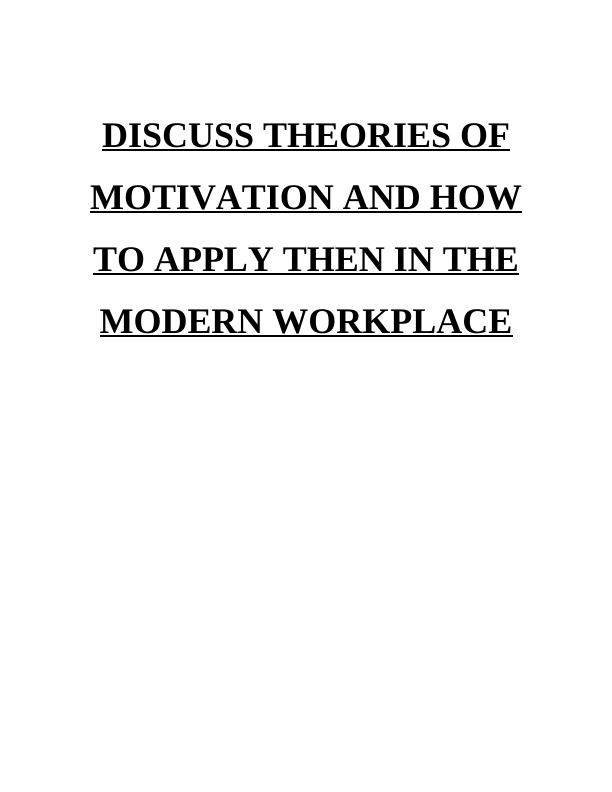
Table of Contents
INTRODUCTION...........................................................................................................................3
MAIN BODY ..................................................................................................................................3
Different theories of motivations.................................................................................................3
CONCLUSION................................................................................................................................6
REFERENCES................................................................................................................................1
INTRODUCTION...........................................................................................................................3
MAIN BODY ..................................................................................................................................3
Different theories of motivations.................................................................................................3
CONCLUSION................................................................................................................................6
REFERENCES................................................................................................................................1
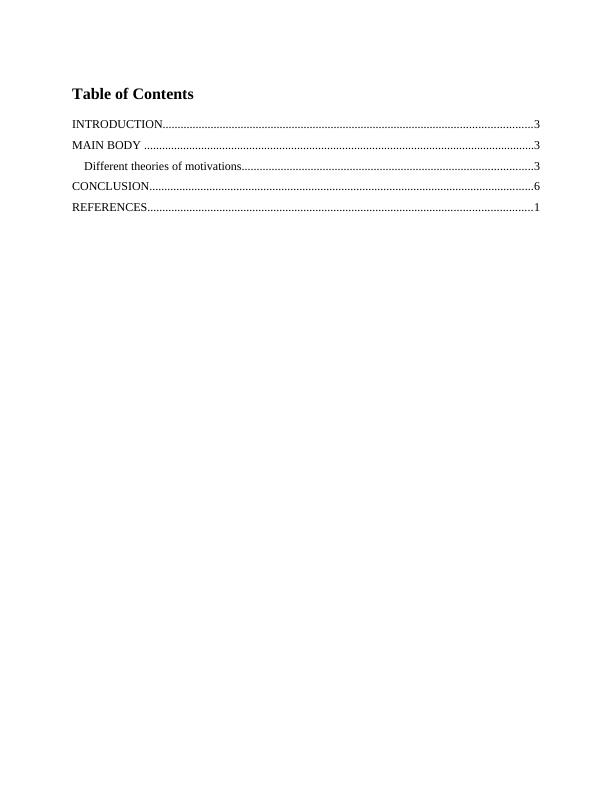
INTRODUCTION
The motivation refers to factor for action, goal and willingness to perform the task by self
(Schunk and DiBenedetto, 2020). This is basically the action or process to provide a reason to
perform something more effectively. This report will evaluate the theories of motivation and
their uses in the modern workplaces.
MAIN BODY
Different theories of motivations
Vroom expectancy theory : This approach of employees motivation is based on the concept that
employee's performance is totally depends on the individual factors and features of their
individual personality, knowledge and skills they have (Miele and Scholer, 2018). This model
uses to separate the performance, outcomes and the efforts of the individual. This approach of
motivation is emphasis on the company which can be related with the individual performance
and rewards given to the respective recipients. This motivation theory present the behavioural
process of an employee choice a behavioural option in respect of other. In this there are three
different variables that are expectancy, valence and instrumentality. As the expectancy is fixed as
per the experience of an individual, instrumentality is the achievement of rewards if the desire
goal is being meet and valence refers to value of any individual put on the benefits of an
outcome.
There are many organizations in the current world are making use of Vroom expectancy
theory to motivate the employees with their organization. For an example in the modern
workplace Apple inc. is using Vroom expectancy theory to motivate its large number of
employees and to achieve the goals in measurable manner (Groat and Shane, 2020). The
organization is offering better rewards to enhance the employee's performance. Apple inc.
concern separately to the employees and provide them benefits. The organization uses to decide
the rewards and by these employees in the modern workplaces are being motivated by this
approach and maximize their potential. after motivating the employees they uses to check that
employees achieve their target and ultimately operation of organization improve.
Adam equity theory of motivation
The motivation refers to factor for action, goal and willingness to perform the task by self
(Schunk and DiBenedetto, 2020). This is basically the action or process to provide a reason to
perform something more effectively. This report will evaluate the theories of motivation and
their uses in the modern workplaces.
MAIN BODY
Different theories of motivations
Vroom expectancy theory : This approach of employees motivation is based on the concept that
employee's performance is totally depends on the individual factors and features of their
individual personality, knowledge and skills they have (Miele and Scholer, 2018). This model
uses to separate the performance, outcomes and the efforts of the individual. This approach of
motivation is emphasis on the company which can be related with the individual performance
and rewards given to the respective recipients. This motivation theory present the behavioural
process of an employee choice a behavioural option in respect of other. In this there are three
different variables that are expectancy, valence and instrumentality. As the expectancy is fixed as
per the experience of an individual, instrumentality is the achievement of rewards if the desire
goal is being meet and valence refers to value of any individual put on the benefits of an
outcome.
There are many organizations in the current world are making use of Vroom expectancy
theory to motivate the employees with their organization. For an example in the modern
workplace Apple inc. is using Vroom expectancy theory to motivate its large number of
employees and to achieve the goals in measurable manner (Groat and Shane, 2020). The
organization is offering better rewards to enhance the employee's performance. Apple inc.
concern separately to the employees and provide them benefits. The organization uses to decide
the rewards and by these employees in the modern workplaces are being motivated by this
approach and maximize their potential. after motivating the employees they uses to check that
employees achieve their target and ultimately operation of organization improve.
Adam equity theory of motivation

This theory is developed to motivate group of people together according to this theory the
employee's contribution is must be equal to the benefits and rewards they are getting must be
equal to motivate an employee (Gopalan and et. al., 2017). This concept is work on the equality
and comparison with one another. Adams theory state that individual must need and fair
relationship between the contribution and the outcomes. As all the employees who are
contributing same level of satisfaction then all of them must get equal level of reward for the
work. The employees in this model will be motivated when they know that rewards and the
benefits which they got are equal to the contribution they have make in the organization. They
also should know that their rewards are smilier to the others in the organization who have
contributed to same level.
Their are number of organization who are running their business effectively by using this
approach to motivate the employees as this is one of the common way to motivate the employees
(Martin, Snapp and Ketcheson, 2020). This theory uses to deal with the manner where
employees use to compare their values with others. This approach is based on the thining their
employees need equality to be more motivated towards the work, one of the biggest example of
this is google, as they use to satisfy their employees. Google is regularly provides different type
of food to their employees so that they are more engaged towards the organization. They are
treating their employees equally at every level within the workplaces and try to skip the
bureaucracy. They uses to encourage the employees to work in their own style and also share
their creative ideas. They are regualrly provide creative environment where employees are
willing to work and also have fun and get the benefits of their contribution.
Mcclelland's needs theory
This is a human motivation theory which shows that they are three main drivers of motivation to
the employees that are needs for particular achievements, power provided to them and affiliation.
This is not being inherent, this is automatically developed with the culture and experience of life.
For motivating the employees the main their factor are need for the achievement is the urge to
get something in return to the contribution. Need of power is the desire of an employee that they
also have certain authority and power within the organization. Needs for affiliation is the need
that every person has to have a social relationship and friends with the organization.
employee's contribution is must be equal to the benefits and rewards they are getting must be
equal to motivate an employee (Gopalan and et. al., 2017). This concept is work on the equality
and comparison with one another. Adams theory state that individual must need and fair
relationship between the contribution and the outcomes. As all the employees who are
contributing same level of satisfaction then all of them must get equal level of reward for the
work. The employees in this model will be motivated when they know that rewards and the
benefits which they got are equal to the contribution they have make in the organization. They
also should know that their rewards are smilier to the others in the organization who have
contributed to same level.
Their are number of organization who are running their business effectively by using this
approach to motivate the employees as this is one of the common way to motivate the employees
(Martin, Snapp and Ketcheson, 2020). This theory uses to deal with the manner where
employees use to compare their values with others. This approach is based on the thining their
employees need equality to be more motivated towards the work, one of the biggest example of
this is google, as they use to satisfy their employees. Google is regularly provides different type
of food to their employees so that they are more engaged towards the organization. They are
treating their employees equally at every level within the workplaces and try to skip the
bureaucracy. They uses to encourage the employees to work in their own style and also share
their creative ideas. They are regualrly provide creative environment where employees are
willing to work and also have fun and get the benefits of their contribution.
Mcclelland's needs theory
This is a human motivation theory which shows that they are three main drivers of motivation to
the employees that are needs for particular achievements, power provided to them and affiliation.
This is not being inherent, this is automatically developed with the culture and experience of life.
For motivating the employees the main their factor are need for the achievement is the urge to
get something in return to the contribution. Need of power is the desire of an employee that they
also have certain authority and power within the organization. Needs for affiliation is the need
that every person has to have a social relationship and friends with the organization.

This approach is also most common type of motivational approach as there are number of
organization who are making use of this theory (Nurdin And et. al., 2018). To motivate the
employees they are fulfilling the all three needs of them. For example Tesco and H&M are using
the Mcclelland needs approach to motivate the employees and provide them all the satisfactory
things within the organization so that their motivation level is being higher, and they can
contribute maximum to the organization and enhance the productivity by the same. They are
providing opportunities to the employees so that they can achieve better position within the
organization by showing the knowledge ans skills as well. Further they also provide the power at
all the department so that their urge for adopting the power is completed by this moreover their
also providing the surrounding where they can easily make social relationship.
Herberg motivation hygiene theory
This approach of motivational theory is having two major factors on which is works on the
people of the organization. This state that there are two factors with the organization which can
satisfy an individual who is working over there (Lamb, 2017). The motivator factor tend to work
on motivating employees so that they can work effectively and harder within the organization.
Another one is hygiene factor in to provide more hygienic environment to the employees so that
they are motivated and their concentration remain one thing. When the organization not able to
work on hygiene then the level of motivation within the employees are going to be low and more
less. With the motivating employees to satisfy employee with they job is not being enough,
organization also have to focus on the hygiene factors of the employees.
The motivation in the employees are done by both the factor so motivator should assist
the employees in a way that they can achieve their targets and also being recognized within the
organization. They are more effective to work on the responsibility and help in the growth of the
organization whereas hygiene factors should be involved in the company policies so that it will
attract the employees (De Vito and et. al., 2018). In the hygiene only the hygienic workplaces is
not involved there are different aspects such as developing relationships, proving better working
condition and also provide favourable remuneration and security to the employees who are
working in the organization. The modern workplaces are using this style to motivate employees
is google. They are using this motivation and make sure that employees can enjoy the
environment while working with the organization. The two factors theory is being completely
organization who are making use of this theory (Nurdin And et. al., 2018). To motivate the
employees they are fulfilling the all three needs of them. For example Tesco and H&M are using
the Mcclelland needs approach to motivate the employees and provide them all the satisfactory
things within the organization so that their motivation level is being higher, and they can
contribute maximum to the organization and enhance the productivity by the same. They are
providing opportunities to the employees so that they can achieve better position within the
organization by showing the knowledge ans skills as well. Further they also provide the power at
all the department so that their urge for adopting the power is completed by this moreover their
also providing the surrounding where they can easily make social relationship.
Herberg motivation hygiene theory
This approach of motivational theory is having two major factors on which is works on the
people of the organization. This state that there are two factors with the organization which can
satisfy an individual who is working over there (Lamb, 2017). The motivator factor tend to work
on motivating employees so that they can work effectively and harder within the organization.
Another one is hygiene factor in to provide more hygienic environment to the employees so that
they are motivated and their concentration remain one thing. When the organization not able to
work on hygiene then the level of motivation within the employees are going to be low and more
less. With the motivating employees to satisfy employee with they job is not being enough,
organization also have to focus on the hygiene factors of the employees.
The motivation in the employees are done by both the factor so motivator should assist
the employees in a way that they can achieve their targets and also being recognized within the
organization. They are more effective to work on the responsibility and help in the growth of the
organization whereas hygiene factors should be involved in the company policies so that it will
attract the employees (De Vito and et. al., 2018). In the hygiene only the hygienic workplaces is
not involved there are different aspects such as developing relationships, proving better working
condition and also provide favourable remuneration and security to the employees who are
working in the organization. The modern workplaces are using this style to motivate employees
is google. They are using this motivation and make sure that employees can enjoy the
environment while working with the organization. The two factors theory is being completely
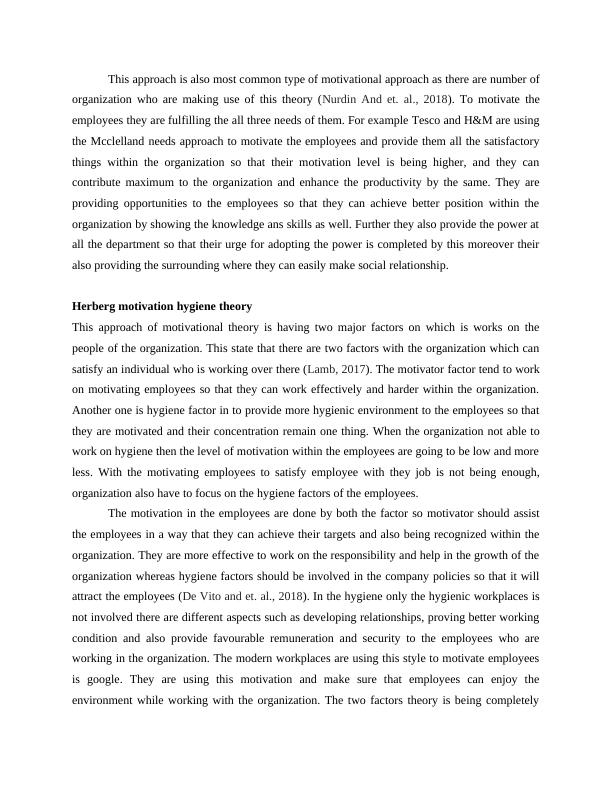
used in Google as they are providing achievement and recognition to the employees as well as
they are providing salary and security to them so that their satisfaction is higher and they are
highly motivated.
CONCLUSION
This report concludes that motivation is being very vital for the organization to assist its
employees to perform best. There are different theories of motivation to motivate group of
people together. These theories help the employees and the employer both by offering
opportunities and achieve the goal as well.
they are providing salary and security to them so that their satisfaction is higher and they are
highly motivated.
CONCLUSION
This report concludes that motivation is being very vital for the organization to assist its
employees to perform best. There are different theories of motivation to motivate group of
people together. These theories help the employees and the employer both by offering
opportunities and achieve the goal as well.
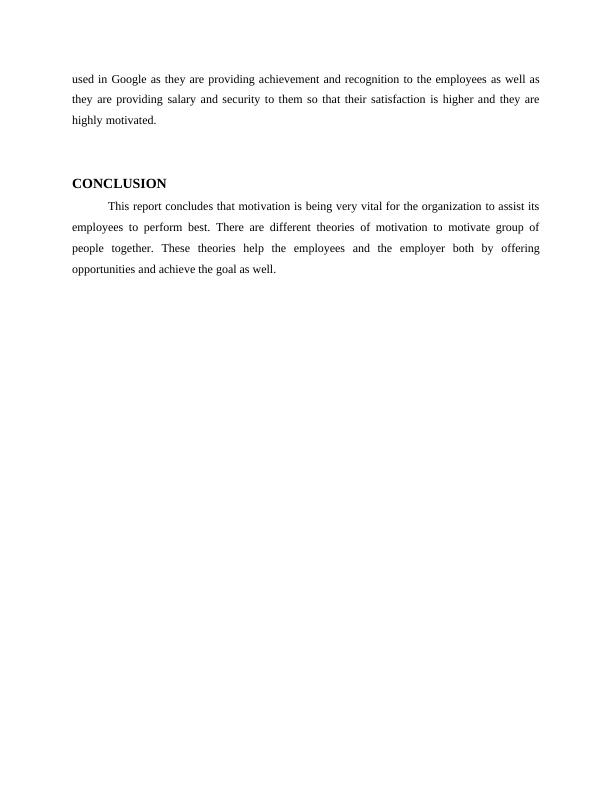
REFERENCES
Books and journals
De Vito, L. and et. al., 2018. Employee motivation based on the hierarchy of needs, expectancy
and the two-factor theories applied with higher education employees. IJAMEE.
Ferreira, T.S., 2017. Motivational factors in sales team management and their influence on
individual performance. Tourism & Management Studies. 13(1). pp.60-65.
Gopalan, V. and et. al., 2017, October. A review of the motivation theories in learning. In AIP
Conference Proceedings (Vol. 1891, No. 1, p. 020043). AIP Publishing LLC.
Groat, L.L. and Shane, M.S., 2020. A motivational framework for psychopathy: Toward a
reconceptualization of the disorder. European Psychologist. 25(2). p.92.
Lamb, M., 2017. The motivational dimension of language teaching. Language Teaching. 50(3).
pp.301-346.
Martin, J.J., Snapp, E. and Ketcheson, L., 2020. Motivational theories. Routledge Handbook of
Adapted Physical Education. pp.347-362.
Miele, D.B. and Scholer, A.A., 2018. The role of metamotivational monitoring in motivation
regulation. Educational Psychologist. 53(1). pp.1-21.
Nurdin, I. And et. al., 2018. The Overview of Motivational Theories in Second Language
Acquisition. Proceedings of AICS-Social Sciences. 8. pp.292-298.
Schunk, D.H. and DiBenedetto, M.K., 2020. Motivation and social cognitive
theory. Contemporary Educational Psychology. 60. p.101832.
Books and journals
De Vito, L. and et. al., 2018. Employee motivation based on the hierarchy of needs, expectancy
and the two-factor theories applied with higher education employees. IJAMEE.
Ferreira, T.S., 2017. Motivational factors in sales team management and their influence on
individual performance. Tourism & Management Studies. 13(1). pp.60-65.
Gopalan, V. and et. al., 2017, October. A review of the motivation theories in learning. In AIP
Conference Proceedings (Vol. 1891, No. 1, p. 020043). AIP Publishing LLC.
Groat, L.L. and Shane, M.S., 2020. A motivational framework for psychopathy: Toward a
reconceptualization of the disorder. European Psychologist. 25(2). p.92.
Lamb, M., 2017. The motivational dimension of language teaching. Language Teaching. 50(3).
pp.301-346.
Martin, J.J., Snapp, E. and Ketcheson, L., 2020. Motivational theories. Routledge Handbook of
Adapted Physical Education. pp.347-362.
Miele, D.B. and Scholer, A.A., 2018. The role of metamotivational monitoring in motivation
regulation. Educational Psychologist. 53(1). pp.1-21.
Nurdin, I. And et. al., 2018. The Overview of Motivational Theories in Second Language
Acquisition. Proceedings of AICS-Social Sciences. 8. pp.292-298.
Schunk, D.H. and DiBenedetto, M.K., 2020. Motivation and social cognitive
theory. Contemporary Educational Psychology. 60. p.101832.
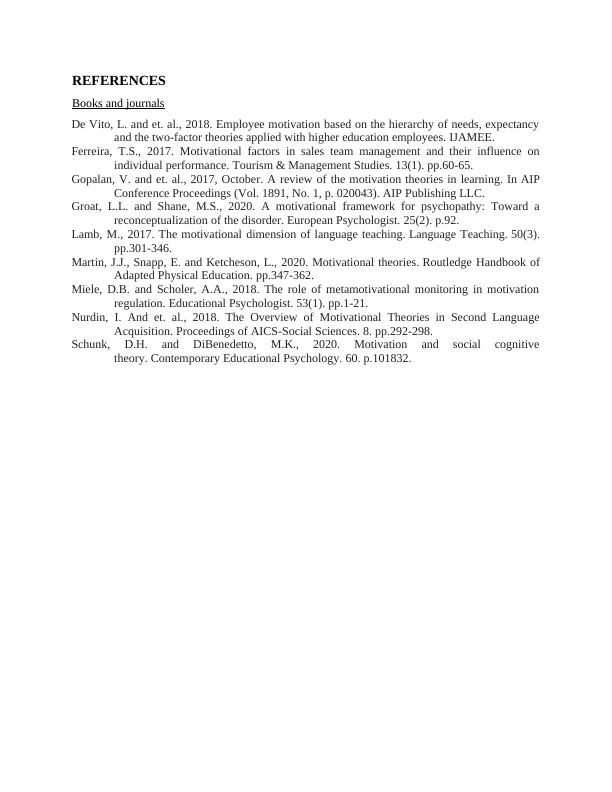
2

End of preview
Want to access all the pages? Upload your documents or become a member.
Related Documents
Managing People and Systemslg...
|8
|1699
|364
Evaluation of Theories and Techniques of Motivation in Apple Inc.lg...
|8
|834
|89
Expectancy Theory and Goal Setting Theory: A Critical Analysislg...
|9
|2368
|475
Motivation Theories for Job Satisfaction in Retail Sector Private Limited Companylg...
|8
|2680
|73
Expectancy Theory of Motivation and Team Effectivenesslg...
|13
|2744
|40
Motivation Theories and Team Roles in Organizational Behaviorlg...
|7
|1485
|34
